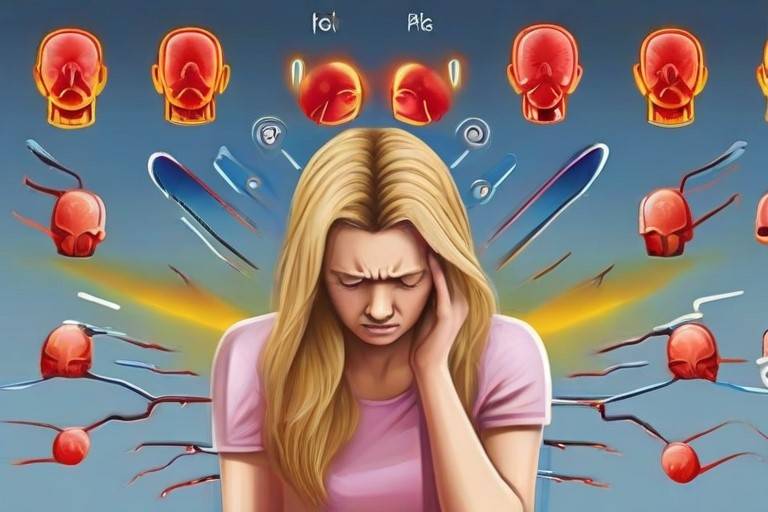Coping with COVID Headache: A Guide to Understanding Symptoms and Finding Relief
Navigate the challenges of COVID Headache with insights on symptoms and effective relief strategies. Discover support for a smoother journey.
Introduction
Headaches have emerged as a surprisingly prevalent symptom among COVID-19 patients. But what qualifies as a COVID headache? And why do experts think it occurs? This introduction unpacks key points about the apparent connection between coronavirus and head pain.
A COVID headache refers to headache symptoms believed to be directly related to the body’s response to the SARS-CoV-2 virus. It may stem from inflammation as the infection impacts the respiratory and nervous systems.
Is Headache a Symptom of COVID-19?
Given the wide range of strange COVID-19 symptoms doctors have documented so far, could headache be among them? Emerging medical research offers insight.
Headaches – An Unexpectedly Common COVID Occurrence
Numerous studies have found a high incidence of headache among coronavirus patients:
- In a Yale University study of hospitalized COVID patients, over half reported experiencing headaches.
- Another study in JAMA indicated nearly 37% of non-hospitalized COVID-positive people had headaches.
- Among the symptoms people often report in seeking initial COVID testing, headache is consistently among the most common early features noted.
So headache seems to frequently accompany COVID infection as an early clue. What’s the link?
Why COVID Causes Head Pain
While research continues, doctors theorize headaches may arise from the body’s inflammatory efforts combatting the virus’ spread:
- Inflammation seems to irritate cranial nerves and blood vessels – squeezing sensitive structures and potentially sparking migraine mechanisms.
- High spiking fevers that come with COVID can also drive headaches by impacting circulation.
- General illness stress on the body – like fatigue, dehydration, lack of nutrition – fuels tension headaches.
Pinpointing what provokes COVID headaches informs treatment priorities for calming these we now know all too common symptoms.
Characteristics and Types of COVID Headaches

COVID seems capable of spurring several primary headache types – or exacerbating preexisting migraine, sinus and tension headaches in those prone to these conditions.
Migraine
Migraine attacks often manifest as:
- Moderate to severe throbbing head pain, typically on one side
- Worsens with physical activity
- Lasting hours to days if untreated
- Additional symptoms like nausea, vomiting, light and sound sensitivity
A small 2020 study in Headache Journal found over 80% of people with preexisting migraine disease experienced worsening symptoms after developing COVID. Viral inflammation appears to trigger cascades of complex neurological and vascular events underlying migraines.
Tension Headache
The steady vice-like pain of tension headaches commonly stems from face, neck, and shoulder muscle tightness. Contributing factors like high fever, dehydration, stress, and poor sleep hygiene frequently accompany infectious illness.
Sinus Headache
When coronavirus irritates intranasal passages and sinus cavities already inflamed from seasonal allergies or infections, intense sinus pressure headaches can result. Burning facial pain often centers on the cheeks, brow and bridge of the nose.
Carefully tracking differences helps distinguish primary drivers – guiding whether abortive migraine relievers, decongestants, anti-inflammatories, or anti-nausea medications offer the fastest relief for COVID headache woes.
What Triggers a COVID Headache?

Doctors don’t yet fully understand why some people with COVID develop headaches while others don’t. Leading theories look to viral impacts on physiology producing a perfect storm of triggering factors:
- Inflammation– The body’s immune response generates inflammation as it tries to fight off infection. Swelling from inflammatory cytokines released systemically could irritate and squeeze cranial nerves or blood vessels enough to spark head pain.
- Fever– High spiking temperatures also seem capable of altering blood flow, creating headaches. Fevers drive up metabolic demands for more circulation while simultaneously expanding blood vessels.
- Dehydration & Muscle Tension– Poor fluid intake and fever-related sweating reduce hydration, creating friction and strain on sensitive nerves and tissues. Tense muscles compress nerves.
- Stress, Exhaustion & Malnutrition– The metabolic stress of combating viral illness leaves reserves depleted – mentally, physically, and nutritionally. Fatigue, heightened anxiety, poor sleep, and insufficient essential nutrients make conditions ripe for headaches.
Since many COVID headache triggers stem from natural consequences of infection-fighting, prompt supportive care restoring optimal homeostasis often brings the swiftest relief.
Treating and Finding Relief from COVID Headaches

If you develop headaches from COVID-19, there are things you can do at home to help yourself feel better. There are also signs to watch out for that mean you should see a doctor.
Helpful Things to Do at Home
Drink lots of fluids – Staying hydrated is very important. Water, sports drinks, broth, juices, popsicles, and jello are good options. The more you sweat from fever, the more fluid you lose. Replacing fluids will help with headaches.
Use OTC pain medicines – Medicines like acetaminophen (Tylenol) or ibuprofen (Motrin, Advil) can ease headache pain and lower fever-causing headaches. Carefully check and follow the dosing instructions on the bottle.
Try hot or cold packs – Ice packs can narrow blood vessels and reduce swelling pressing on pain nerves. Heating pads help relax tight shoulder and neck muscles which also trigger headache pain. Use whichever feels best to you.
Eat nutrient-rich foods – Fruits, veggies, whole grains and lean protein give your body fuel. Things like bananas, spinach, nuts or salmon have vitamins and minerals with healing and anti-inflammatory powers.
Practice relaxing activities – When you don’t feel well, it’s easy to feel stressed. Deep breathing, gentle stretching, meditation, or music therapy activate the body’s natural calming systems to relieve tension fueling headaches.
Call Your Doctor If You Have:
- Fevers over 102°F
- Sudden explosive headache pain
- Headache that keeps getting worse
- Headache and other symptoms lasting over 1 week
- New problems like rash, vision changes or thinking clearly
Keeping a symptom diary noting headache patterns, characteristics, and what makes you feel better guides doctor treatment plans just for you.
Preventing Headaches After COVID Recovery
Getting over a COVID-19 infection is usually the priority. But lingering headaches or developing new ones post-infection remains a common concern needing attention – even after initial recovery.
Taking measures to prevent headaches and properly manage any that surface helps given COVID’s proclivity to spark pain. Strategies include:
- Staying hydrated- Make water, herbal tea, broths or electrolyte drinks daily habits to avoid dehydration and irritation headaches. Eat water-rich fruits and veggies too.
- Eating nutritious foods- A balanced diet fuels healing reserves tapped heavily during illness. Complex carbs, lean proteins, healthy fats, fruits, and veggies restore what’s depleted.
- Prioritizing sleep– Quality sleep gives the brain and body a reprieve to fully recover. Follow consistent sleep/wake times. Limit digital devices before bedtime.
- Practicing stress reduction– Lingering anxiety, depression, and tension often accompany serious illness. Counselling, deep breathing, gentle yoga, meditation soothe.
- Use medicines judiciously– Frequent OTC painkiller use risks rebound medication overuse headaches for some post-COVID.
- Be evaluated for lingering issues– If concerning headache patterns emerge or persist for weeks after the acute infection, seeking medical guidance helps determine contributing drivers needing targeted treatment. Tracking characteristics and relieving factors in a headache diary speeds assessments.
COVID Headache. Addressing post-COVID headache trends is vital. It ensures lingering irritation or secondary impacts don’t disrupt people working to get back to full speed after illness. Keep it simple for a smoother recovery.
Key Takeaways
- Recognizing that headache commonly manifests among broader COVID-19 symptoms aids in prompt diagnosis and care-seeking.
- While usually manageable at home initially, worsening head pain or debilitating characteristics should prompt medical evaluation for targeted relief options.
- Preventively staying hydrated, reducing illness-related stressors, and cautiously using OTC medications help calm headaches during and after COVID illness.
- Keeping a symptom journal, and tracking pain location, intensity, duration, and relieving factors helps distinguish primary headache drivers – guiding optimal treatment both acutely and for lingering head discomfort post-infection.
- Getting headaches under control speeds up COVID recovery and return to normal function – while also reducing the risk of post-viral complications down the road.
The bottom line
COVID Headache is more than just a pain. Being aware that headaches could signal COVID helps in taking early self-care steps at home. If the pain persists or feels severe, seeking clinical guidance is crucial. Understanding this connection is key to finding the right relief.
FAQs About COVID Headache
Here are the common frequently asked questions about COVID Headaches and the best answers.
What does the COVID headache feel like?
A COVID headache often feels like a persistent, pulsating pain in the head. It’s typically described as a pressing or tightening sensation, rather than throbbing. Unlike regular headaches, a COVID headache is usually felt all over the head and may be accompanied by other symptoms such as fever, fatigue, and loss of smell or taste. It’s often more resistant to regular painkillers and can feel more intense when bending down or moving the head.
Why does COVID-19 hurt your head?
COVID-19 can cause headaches due to a combination of factors. The virus triggers an immune response in the body, which can lead to inflammation and subsequently cause a headache. Additionally, COVID-19 affects the vascular system, and changes in blood vessel behaviour can also contribute to headaches. Stress and anxiety related to the illness, dehydration due to fever, and prolonged bed rest might exacerbate the headache.
What medication is good for COVID headaches?
Over-the-counter pain relievers like acetaminophen (Tylenol) or ibuprofen (Advil, Motrin) can be effective for COVID-related headaches. However, it’s important to follow the dosage instructions and consult with a healthcare provider, especially if you have underlying health conditions or are taking other medications. In some cases, your doctor might prescribe specific medication if the headache is severe or persistent.
How long do post-COVID headaches last?
The duration of post-COVID headaches can vary. Some people experience headaches for a few days, while others may have them for weeks or even months after recovering from the virus. This is known as a “long COVID” symptom. The persistence of the headache often depends on the individual’s overall health, the severity of their COVID-19 infection, and how their body responds post-recovery. If headaches persist or worsen, it’s crucial to seek medical advice for appropriate management and treatment.



